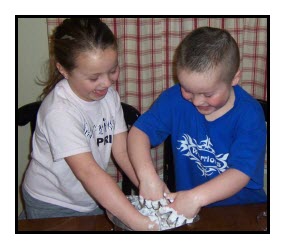Adding Information and Challenges to an Exploratory Slime Investigation
The kids shown are having fun making slime by mixing together cornstarch and water.
Sometimes you want kids to be surprised by the results of an experiment. But, usually, the best results is for kids to know what to do and what to expect. Videos can provide information in a fun way.
I’ve selected a YouTube video that demonstrates some of the unique and even mystifying physical properties of cornstarch slime.
The video is fun, but the real fun comes from making the slime yourself. While the video doesn’t give a recipe, I suggest that you make the slime Using This Cornstarch Slime Recipe.
This is an example of an exploratory investigation, meaning it is a type of research done with the purpose of collecting information also called data.
Housecleaning
When you decide the kids have had as much “messy” fun as you can stand, stop the investigation and clean up.
Keep the slime in a container with a lid for further investigations. (The lid keeps out contaminants and prevents the slime from dehydrating.)
Since Cornstarch Slime Can Clog Drains, the safest way to dispose of the cornstarch on hands is to rinse hands in a container of water, which can be thrown outdoors.
Challenging Questions
Either now or later, explain that slime behaves the way. Clue: Cornstarch slime is a non-Newtonian Fluid
Instead of ending the corn starch slime investigation, brain-storm ideas that could lead to further explorations. In fact, at this point, a question for a science project could very easily develop from this brain-storming session.
Give the kids hints by asking question and/or remind them of any questions they previously asked when investigating the slime. Inquiry questions such as:
1. Does the recipe have to be exact? What would happen if the ratio of water and cornstarch was changed?
2. Does temperature affect the slime?
Develop Inquiry Questions into Science Project Questions
I will use a template to write change the inquiry questions into science project questions. No, it is not a perfect template, but it give us something to work with. One of the blanks is an independent variable and the other is a dependent variable.
What effect—————————have on ___________________?
1. What effect does the ratio of water and starch have on the viscosity of cornstarch slime?
2. What effect does temperature have on the viscosity of cornstarch slime?
These are example questions–you can decrease or increase their complexity, for example:
What effect would adding food coloring have on how fast slime spreads out?
Have fun playing and learning about non-Newtonian fluids.
The book is designed to help young students catch the “science bug”
Teaching the Fun of Science to Young Learners
The book’s 75 lessons and reproducible activities touch on all areas of science and provide the key to a world of science magic and mystery. While kids will have fun doing the activities and learning to love science, they are also being encouraged to develop other skills, including reading, writing, math, and art.
(Paid Link)

